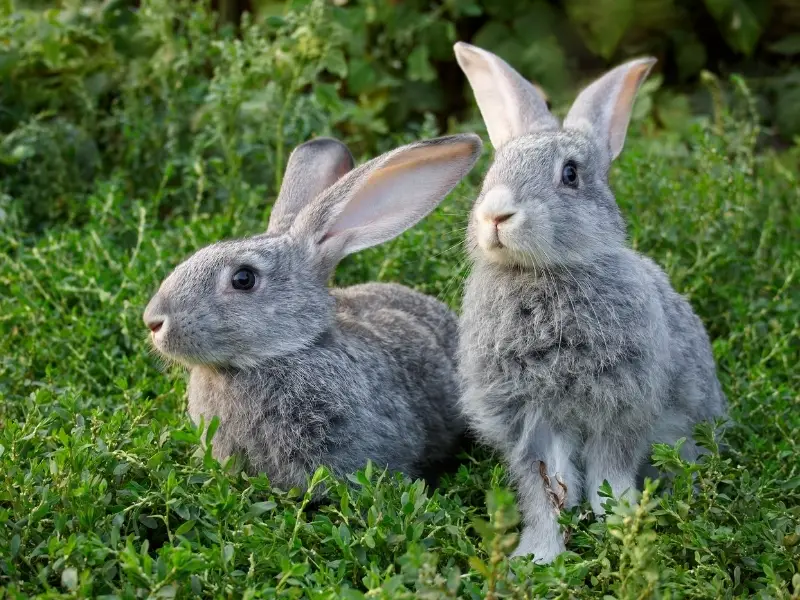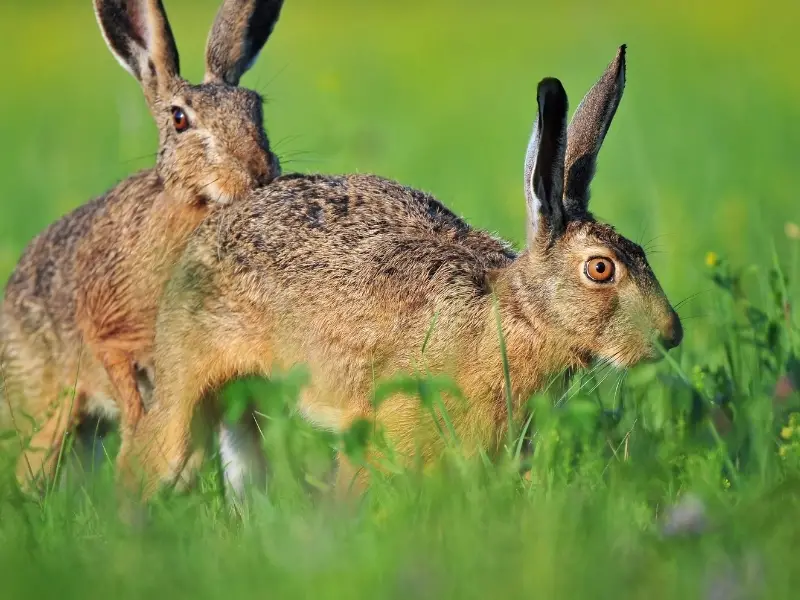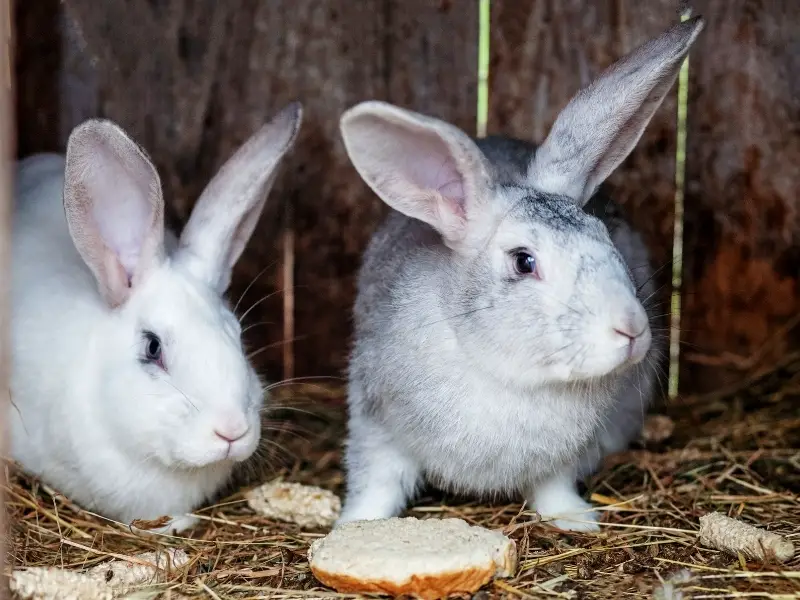Rabbits are social animals, and while it would be amazing if you could just play with your fluffy bestie all day long, that isn’t exactly practical. Getting another bunny makes perfect sense, but this is only ideal if the two rabbits are bonded.
Bonding rabbits is when you introduce two rabbit “strangers” and they become best friends. How do you go about getting rabbits to bond?
To bond two rabbits, keep them separated, and introduce them so they can become acquainted. When they are more comfortable, put them together for short periods and gradually increase the time they spend with each other. Once they start grooming and eating together with no aggressiveness, they are bonded.
Bonding rabbits may seem quite daunting, and you may have so many questions, from where to start, how to know your bunnies are bonded, and more. So let’s get started.
Rabbit Bonding Introduction
It’s rare that rabbits fall in love at first sight and just bond instantly. Most of the time, you need quite a bit of patience, persistence, and time to bond two bunnies.
The reward of having two bunnies bonded is that it brings joy and fun for the rabbits and you, so don’t give up.
Before you introduce a second bunny to your home, there are a few things you need to do:
- Ensure both bunnies are healthy as an ill bunny will feel uncomfortable and not up to socializing.
- Unless you want to bond your rabbits for breeding purposes, neutering both bunnies makes the bonding process smoother as unneutered bunnies are more likely to be aggressive and territorial, and they’ll fight with each other.
- Not all rabbit personalities get along, so if you can, take your pet rabbit to a shelter so it can choose its own bonding partner. Alternatively, foster another bunny for a while to see if the match could work.
- Make sure you can house the two bunnies separately, and then also swap them so they can live in each other’s cage or hutch on alternate days.
- Have a neutral space that neither bunny will consider as their own space.
- Have equipment, like a squirt bottle, thick gloves, and a dustpan and broom, to break up bunny fights.
- Ensure you can afford a second bunny.
Possible Types of Introduction
While it is easiest to bond a neutered male and spayed female rabbit, other types of introductions and bonds are possible too.
Also quite interestingly, it is better if you already have a male bunny and then bonds it with a female rabbit than the other way around. But if you choose to bring home two non-bonded pet rabbits at the same time, the new environment helps them become friends more easily.
Boy and Girl
A female and a male bunny can fall in love at first sight, but this isn’t always the case. Still, this pairing is easier than some of the others.
Girl and Girl
The female-female rabbit bonding process can be quite easy too, but this isn’t guaranteed. These bunnies sometimes fight a lot before they are fully bonded.
Boy and Boy
Another same-sex rabbit pair is bonding a male rabbit with another male rabbit. Like the female-female pair, this can either be easy or take a bit of patience and work.
Two Babies
Another bonding type that’s quite easy is bonding two kittens (or baby rabbits) with each other. Bond two kittens that are under 12 weeks and have been neutered for the best results.
Baby and an Adult
If the mature bunny is quite tolerant, then you can bond a kitten with an adult rabbit; however, this bonding process may be challenging.
Three or More Rabbits
This pairing is easier if two of the bunnies are not yet bonded; however, the overall difficulty of this bonding process depends on the personalities and sexes of the rabbits.
How to Introduce the Would-Be Bonded Pair of Rabbits

There are a variety of methods to introduce the pair of rabbits you want to bond, but we recommend following the three S’s:
Scent
Rabbits communicate via scent, so if possible, swap bedding and toys so the two rabbits can get a sense of each other before they meet. It’s like a polite handshake and makes the first meeting a lot easier.
Sight
Next, keeping the rabbits in their separate cages, let them see each other. They will also be able to hear and smell each other. If you have a rabbit house, use a baby gate to keep them in separate rooms for now.
Snacks
Feed them together—one on each side of the barrier so they can grow to be more comfortable with each other.
The Next Steps
Once the bunnies are happily lying close together on either side of the barrier, you can move to the next steps.
On neutral ground, let them meet face-to-face. Ensure there are loads of distractions, like food and toys so it feels like a playdate and the bunnies can just have fun. There should also be some hiding spaces, like cardboard boxes and tubes, so if one rabbit feels a bit stressed, they have a space to hide.
When you introduce the rabbits on neutral ground, place one rabbit on one end and the other bunny on the opposite end of the enclosure. Now they can decide whether they want to size each other up or just meet in the middle.
Remember to keep a close eye on the pair; if they fight or one rabbit looks stressed, end the session, and try again the next day.
You can also do these sessions on neutral territory for 10 minutes every day; the more often you try to bond the pair, the better it will be (compared to only doing it for 20 minutes twice a week).
What Will Possibly Happen After Introduction?
After you’ve introduced the two bunnies, there are a few possibilities of what could happen:
Amorous Behavior
If you’re trying to bond a male bunny with a female bunny, the male may try to mount the female rabbit. In some cases, the female bunny is okay with this. However, if she runs or becomes aggressive, it just means that the bonding process will take longer.
Mounting isn’t only sexual behavior, it is also a sign of dominance. Don’t let the mounting behavior last longer than 30 seconds since the submissive rabbit may become frustrated.
Fighting
If the pair of rabbits that you are trying to bond fights, then you are in for quite a challenging and lengthy bonding process. And you also need to be prepared to break up the fights.
Friendship
The two bunnies may become tentative friends at first. This is a good sign; however, be sure to keep the bunnies apart and separate when you are not around.
Love
If the bunnies fall in love with each other at first sight, then you can put them in the same space and see how they get along. If there are no fighting or distress signals, then all’s fine.
Chasing
It’s quite possible that one rabbit may chase the other one. Just watch for now and ensure no bunny gets hurt. If there is no fighting, continue to watch. If a rabbit does get hurt or they fight with each other, keep them separate and slow down the introductions.
Don’t allow the rabbits to chase each other for longer than 30 seconds as you don’t want it to escalate.
Marking
Rabbits may mark their territory by urinating or pooping on the neutral ground. This isn’t an indication of whether the rabbits are getting along or not.
Nipping
You may see the rabbits lightly nipping at each other. It’s merely another way they communicate to tell the other bunny to leave them alone. If it occurs more often or is followed by aggressive behavior, then go back to the drawing board and take a different approach to bond your bunnies.
Bowing
This isn’t a sign of cuddling. Instead, when one rabbit bows to another, it is asking to be groomed. Whichever bunny is groomed first is the dominant rabbit in the bonding relationship.
However, watch out for a fight or standoff if one rabbit takes it to heart when the other rabbit doesn’t want to groom them.
Laying Close to Each Other
If the bunnies are laying near each other, it’s a sign of trust.
Mirroring
When the rabbits copy each other’s behavior, they are mirroring. For example, one rabbit may lay down, and then the other will follow.
Grooming
This is a positive behavior, meaning that the bunnies feel comfortable and love each other. When rabbits groom each other, they lick each other around the ears and forehead first.
Neutral Rabbit Space

You need a neutral space for the rabbits to meet face-to-face after you’ve introduced them to each other in their separate cages. A neutral area is one that no rabbit will think of as their territory.
Neutral space ideas include the kitchen, a part of your hallway, patio, guest bedroom, or bathroom.
Any equipment you use in this space when bonding two rabbits should be neutral too. This means you need to use a new exercise pen, new litter boxes, hiding houses, toys, and food bowls.
You’ll need two of everything because the bunnies you are trying to bond with may not like sharing everything from the start.
Factors to Consider When Bonding a Rabbit
There are a few considerations to keep in mind when you want to bond two rabbits:
- If you are spending lots of time with your bunny and it seems happy, then you don’t necessarily need to find another rabbit to bond them with.
- However, if you aren’t home a lot and you want to prevent your fluff ball from being lonely and depressed, then consider bonding them with another bunny.
- Ensure you can keep both rabbits separate until they are fully bonded to prevent fighting and injuries.
- Make sure you can afford to take care of the two bunnies; there will be a significant cost increase from taking just care of one rabbit.
- Neuter both rabbits before you bond them.
- Do you have the time and patience it will take to bond two rabbits?
- Do you have a neutral area when you can allow face-to-face and play time? Ensure you don’t leave the rabbits alone together in this neutral space until they are fully bonded.
- The age of your bunny should be a factor since older rabbits take less easily to being bonded and it can cause health problems for your elderly bunny.
- Don’t do stress bonding where you enclose both rabbits in a very small space or during car rides; this puts the rabbits in a scary situation and poses risks to their welfare and safety.
- It’s best to bond two rabbits that have been spayed or neutered.
- Don’t bond them immediately after the bunnies have been desexed; males take up to 6 weeks after being neutered to become sterile and wait at least 2 weeks before bonding a spayed female bunny so the wound can heal.
Dos and Don’ts When Bonding Rabbits
Follow these tips during the bonding process:
Dos of Bonding Rabbits
When you bond one rabbit with another, do:
- Keep the rabbits separate but close together so they can get used to each other
- Understand that the bonding process takes time and patience
- Expect that not every bonding session will go smoothly and be prepared to adapt how you bond the bunnies
- Pay equal attention to both bunnies so they don’t get jealous of each other; this could ruin the bonding process or make it all the more challenging
Don’ts of Bonding Rabbits
When bonding a pair of rabbits, avoid:
- Assuming that things will go well; instead watch and react swiftly if needed
- Leaving the rabbits alone and unsupervised; you can only leave them alone once they are fully bonded
- Doing a bonding session with the bunnies if you’ve had a bad day as your emotions will transfer to them and the bonding session won’t go well
- Playing favorites
- Expecting the bonding to take a day or two
- Doing a bonding session in the territory of one rabbit; instead, always use neutral ground until the pair is fully bonded
How Do I Know When My Rabbits Are Bonded?
When your bunnies are bonded, look for the following signs. The rabbits:
- Mutually groom each other
- Don’t chase each other aggressively
- Share their food
- Use the same litter box
- Get along
- Play together
- Sleep next to each other
How Long Does It Take for Rabbits to Bond?
It can take as little as one day or as long as a few months for rabbits to bond; however, this all depends on the two bunnies. In general, it will be a few weeks before the bonded pair will “live happily together.”
The Final Bond
If you have the time, energy, resources, and patience to bond your rabbit with another because you are scared your bunny is lonely and depressed because you can’t spend a lot of time keeping it company, then do consider bonding two rabbits.
There are several key factors to keep in mind (besides the time, energy, patience, and resources).
If you’ve carefully thought about all of these, then good luck and happy bonding!
Related Articles:

